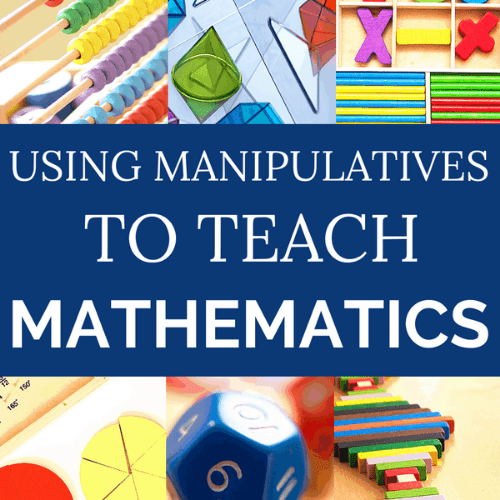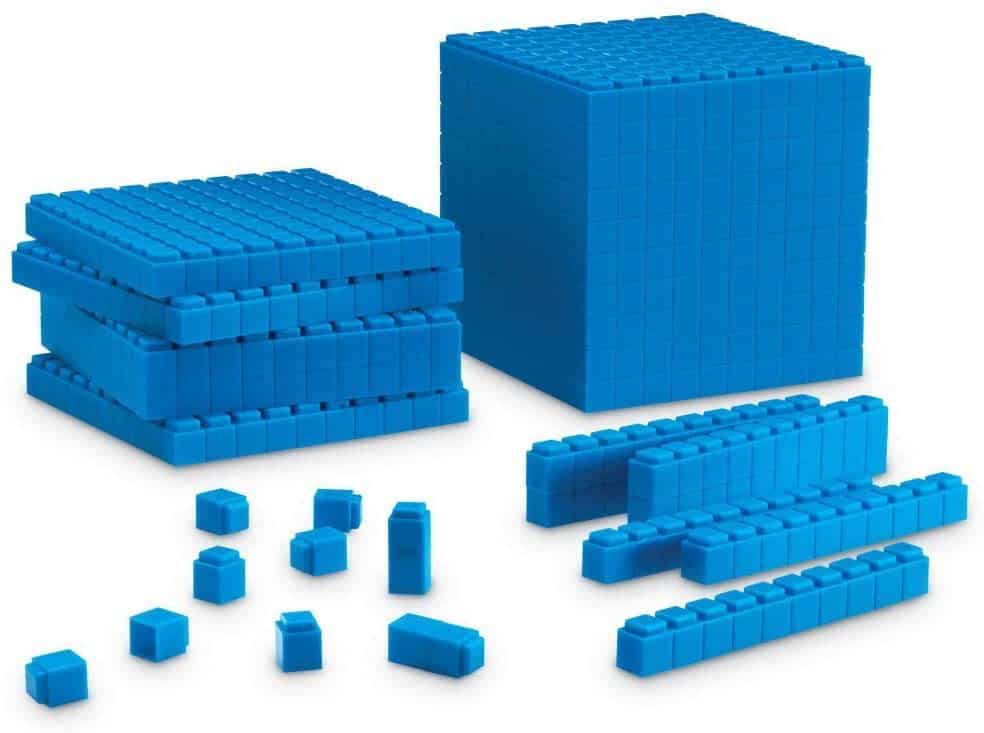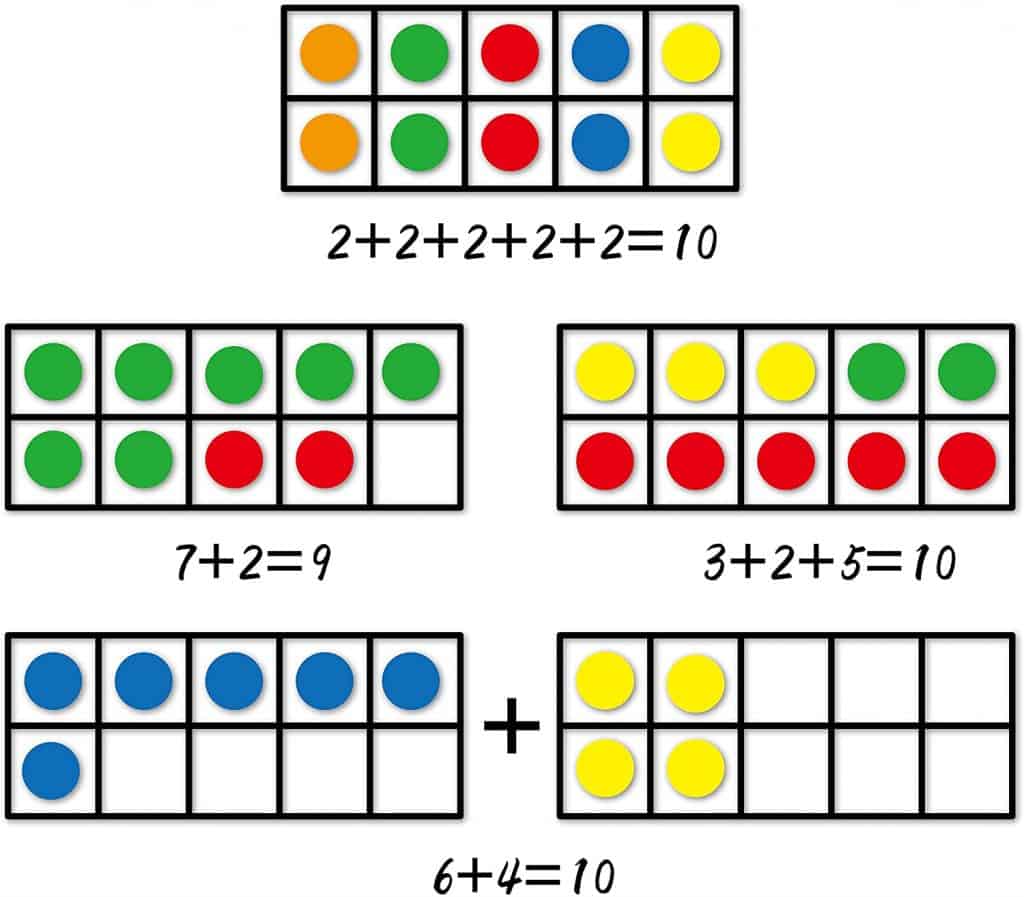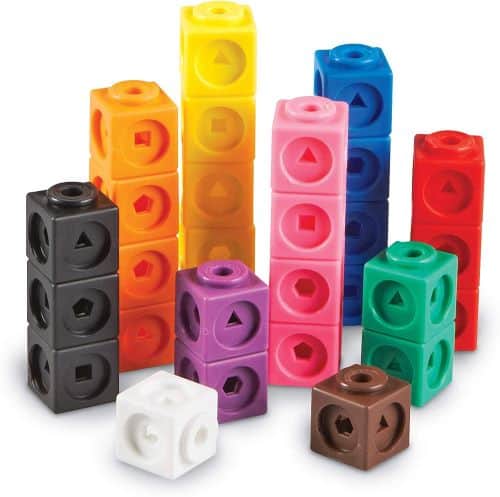Did you know the use of manipulatives (physical objects) to help with solving everyday math problems was actually an ancient practice? The ancient Middle East used counting boards, while the ancient Romans, Greeks, and Chinese used the abacus. Fast forward through the corn kernels strung on strings used by the Incas and Aztecs to the similar replicas adopted by the Americas, one thing rings true – manipulatives are an important element in helping children develop an in-depth understanding of math concepts.
The Singapore Mathematics method in elementary grades uses the concrete to pictorial to abstract learning approach to encourage active thinking, understanding, and communication of mathematical concepts and problem-solving. At the concrete stage, manipulatives are used to help students gain a deeper understanding of math concepts.
Manipulatives can be used to teach a variety of mathematical topics.
You may remember those little blocks or coin-sized materials we had in elementary school. They were fun to play with indeed; however, they have much greater use in teaching a variety of topics within math.
Manipulatives can be used to teach:
- Problem-solving
- Spatial-memory
- Symmetry
- Mathematical operations
- Base-ten
- Geometric shapes
- Patterns
- Ordering
- Sorting
- And much more!
It is proven that the use of manipulatives supports children’s ability to both learn and comprehend concepts that would otherwise be difficult to understand. Although manipulatives can be used to teach just about every math concept known to man, there are a few key areas that research shows manipulatives are especially helpful in:
- Counting
- Place value
- Computation
- Problem-solving
- Fractions
- Ratios
- Algebraic abilities
Perhaps you’re able to identify a few areas that your child needs in improvement in. There’s no doubt that using math manipulatives will help enhance weak areas while building a strong foundation for future concepts to be taught.
Benefits of Using Manipulatives
According to research conducted by Hand2Mind, the use of manipulatives in mathematics have helped children gain traction in the following areas:
- Verbalize mathematical thinking.
- Discuss math ideas and concepts.
- Connect real-world situations.
- Solve problems in a variety of ways.
- Take ownership in learning.
- Gain confidence in one’s ability to find solutions.
Reading those points should make any parent (and teacher) smile as these are the goals we have for our children, yet so often many children don’t quite experience it. That’s where utilizing additional resources, such as manipulatives, come into play.
Best Math Manipulatives
One quick search and you’ll find tons of manipulative resources that can easily be incorporated into your homeschool, but to help make your search easier, we’ve compiled a quick list below:
Base Ten Sets (Interlocking)
The benefit of interlocking base ten sets is the ability for children to manipulate and visualize a variety of quantities while clarifying place value, estimation, and other operation concepts. Base ten sets help teach:
- Primary concepts (addition, subtraction, multiplication, division)
- Number sense
- Place value
- Decimals
- Regrouping
Ten Frames
Ten frame cards give your child the visual support they need to understand the different combinations that make 10, which is an important foundational mathematical concept. Ten Frames can be used to teach addition and subtraction.
Mathlink Cubes
A highly popular manipulative, Mathlink Cubes link together on all sides and are great for teaching math skills such as:
- Counting
- Comparison
- Making 10
- Measurement
- Grouping
- Addition and Subtraction
- Colors
- Patterns and Shapes
- Sorting and Matching
- Problem Solving Skills
Square Tiles
Another math manipulative favorite, square tiles can be used by children to explore and build colorful patterns, be used as counters, and learn addition and subtraction, learn to compare and contrast and learn measurement.
Pattern Blocks/ Geometric Shapes
Children can easily learn how to analyze, compare, and compose 2-D shapes with pattern blocks. The variety of colors and shapes help them explore symmetry, area, shapes, measurement, and more. These blocks can also be used for learning patterns, sorting, and attribute recognition.
Cuisenaire Rods
Cuisenaire Rods are great for exploring whole numbers, mathematical operations, ratio, symmetry, congruence, and patterns. They can also be used to teach kids to understand math concepts as they progress from concrete representation to abstract thinking.
Geoboards
Children LOVE geoboards and rightfully so. Geoboards give children the opportunity to experiment with:
- Creating shapes
- Rotating shapes
- Exploring angles
- Exploring the properties of geometric objects
Fraction Circles/ Fraction Tiles
Fractions are typically one of the most difficult concepts to pick up for children, yet when they have a manipulative such as the fraction circles, the concept tends to click a bit easier.
Although there are many more math manipulatives you could consider, these are some of the most popular and offer versatility in learning. Concepts taught with this manipulative are:
- Whole and part
- Fractions
- Adding and subtracting fractions
- Multiplying and dividing fractions
How to Use Manipulatives
If you are using any of the Singapore Mathematics curriculums, you will find instructions in the teacher’s manual on using manipulatives to teach. Many other curriculums also use manipulatives to teach math. Many manipulatives also come with activities and instructions.
Hands-On Standards
One great resource is the Hands-On Standards books. They provide photo-illustrated lessons for teaching math with manipulatives. Each lesson defines the concept and skills that would be taught.
| Image | Title | Price | Prime | Buy |
|---|---|---|---|---|
 | Learning Resources Base Ten Blocks Smart Pack, Early Childhood Math Skills, Ages 5+, Multicolor | PrimeEligible | Buy Now | |
 | Torlam 131 PCS Base Ten Blocks for Math - Place Value Blocks, Plastic Base 10 Math Manipulatives 1st Grade, Math Counters, Number Blocks, Math Cubes, Counting Cubes for Kids Math | PrimeEligible | Buy Now | |
 | EAI Education Base Ten Intermediate Classroom Set, Blue Plastic | Early Learning Math Manipulative for Counting, Number Concepts and Place Value - 844 Pieces | PrimeEligible | Buy Now | |
 | edxeducation Linking Cubes - Set of 100 - Math Manipulatives for Construction and Early Math - For Preschoolers 3+ and Elementary Students | PrimeEligible | Buy Now | |
 | Learning Resources MathLink Cubes, Back to School Activities, Homeschool, Classroom Games for Teachers, Educational Counting Toy, Math Cubes, Linking Cubes, Early Math Skills, Math Manipulatives, Set of 100 Cubes, STEM toys, Ages 5+ | PrimeEligible | Buy Now | |
 | hand2mind Interlocking UniLink Cubes, Plastic Cubes for Early Math, Connecting Cubes for Kids Learning, Math Manipulatives, Counting Cubes for Kids Math, Preschool Classroom Supplies (Set of 500) | PrimeEligible | Buy Now | |
 | hand2mind Plastic Square with 7 Color Tiles, Math Counters for Kids, Math Manipulatives for Counting, Sorting, Pattern, Bingo Chips, Game Tokens, Homeschool Supplies (Set of 400) | PrimeEligible | Buy Now | |
 | hand2mind ETA ManipuLite Color Tiles, Set of 400 | Prime | Buy Now | |
 | hand2mind Foam Square Color Tiles, Math Counters for Kids, Math Manipulatives for Counting, Sorting, Pattern, Bingo Chips, Game Tokens, Homeschool Supplies (Set of 40) | PrimeEligible | Buy Now | |
 | Melissa & Doug Abacus - Classic Wooden Educational Counting Toy With 100 Beads | PrimeEligible | Buy Now | |
 | Educational Abacus for Kids Math - 10 Row Wooden Counting Frame with Number 1-100 Cards - Teach Counting, Addition and Subtraction Math Toys, Preschool Learning Toys for Boys Girls Gift 3 4 5 Year Old | PrimeEligible | Buy Now | |
 | Melissa & Doug Add & Subtract Abacus - Educational Toy With 55 Colorful Beads and Sturdy Wooden Construction | PrimeEligible | Buy Now | |
 | Kids First Math: Attribute Blocks Math Kit with Activity Cards | Develop Skills in Logical Thinking, Classifying, Comparing | Visual Hands-on Math for At-Home or Classroom Learning, Ages 3+ | PrimeEligible | Buy Now | |
 | hand2mind Plastic Attribute Blocks Student Kit, Geometry Set, Preschool Learning, Manipulatives for Preschool, Montessori Math, Shapes for Toddlers, Home Schooling Materials Pre-K (Set of 60 Blocks) | PrimeEligible | Buy Now | |
 | Learning Resources Attribute Blocks Desk Set in Tray | PrimeEligible | Buy Now | |
 | Learning Resources Cuisenaire Rods Small Group Classroom Set, Math Class, Teacher Aids, 155 Piece Wood Set,Multi-color | PrimeEligible | Buy Now | |
 | ROBUD Cuisenaire Rods Individual Kit, Montessori Math Learning Tools, Math Manipulatives for Kids | PrimeEligible | Buy Now | |
 | hand2mind Plastic Cuisenaire Rods Individual Kit, Hands On Math Manipulatives for Kids, Montessori Math Number Rods, Fraction Manipulatives, Math Blocks for Counting, Homeschool Supplies (Set of 74) | PrimeEligible | Buy Now | |
 | hand2mind Plastic Rainbow Fraction Tiles, Montessori Math Materials for Kids to Learn Fraction Equivalence Math Manipulatives 4th Grade Fraction, Homeschool Supplies (15 Sets of 51 Pieces) | PrimeEligible | Buy Now | |
 | Learning Resources Rainbow Fraction Tiles, Early Math Skills, Visual Aid, Ages 7+ | PrimeEligible | Buy Now | |
 | hand2mind ETA Rainbow Fraction/Decimal Tiles | PrimeEligible | Buy Now | |
 | Learning Resources Primary Bucket Balance Teaching Scale, Science/Math, Classroom Scale, Science for Kids, Ages 3+ | PrimeEligible | Buy Now | |
 | Learning Resources Bucket Balance, 1g Sensitivity, Mass Measurement, Includes Buckets, Ages 3+ | PrimeEligible | Buy Now | |
 | hand2mind Plastic Bucket Balance for Kids Ages 5-8, Hands-On Way to Learn About Weight and Measurement, 2 Clear 1/2 Liter Buckets with Spouts for Easy Pouring (Set of 1) | PrimeEligible | Buy Now | |
 | Learning Resources Hands-On Standards Handbook, Grades PreK to K | Prime | Buy Now | |
 | Learning Resources Hands-On Standards: Photo-Illustrated Lessons for Teaching with Math Manipulatives, Grades 1-2,Blue,54 x 72 Inches | PrimeEligible | Buy Now | |
 | Hands-On Standards Deluxe Edition The First Source For Introducing Math Manipulatives (Grades PreK-K) | Prime | Buy Now | |
 | hand2mind - 93533 Hands-On Standards, Learning at Home Family Engagement Kit for Grade 3, Math Activity Book with Math Manipulatives, Spanish Translations for Key Materials | PrimeEligible | Buy Now | |
 | Hands-On Standards Science, Deluxe Edition Grades K-1 | PrimeEligible | Buy Now |
Creating Your Own Manipulatives to Teach Math
Whether investing in manipulative resources is in your budget or not, there are a variety of ways you can create your own manipulatives to teach math. Most of the suggested supplies below can be found around your home or purchased from a local dollar store:
- Craft sticks (also known as popsicle sticks)
- Rubberbands
- Dried beans
- Legos
- Wooden blocks
- Colored beads
- String or yarn
- Cheerios (makes for an edible fun manipulative)
- Dice
- Measuring spoons (and cups)
- Ruler (or measuring tape)
With these supplies in mind, you can teach many different concepts. Craft sticks can be used to teach place value, borrowing and carrying, addition, subtraction, multiplication, and division. Small counters – think beans, legos, and small wooden blocks – can be used to teach concepts such as counting, number recognition, ordinal numbers, concepts of ten, and more or less.
Pull out the dice to create fun number games such as quick counting, fast adding, or even something as simple as number recognition. Blocks, especially those in different shapes and sizes, can be used for comparison, patterns, counting, and place value.
Easily teach measurement concepts with rulers, measuring tapes, spoons, and even the scale you already have in your kitchen. Hang on to your next gallon, half-gallon, or quart-sized container once it’s empty for your children to use for fun hands-on learning.
The possibilities are virtually endless and learning math can become a fun adventure. If you’re looking for math curriculum, resources, and materials, be sure to check out all we have to offer!
Jumbo Magnetic Base Ten Blocks
Ten Frames
Mathlink Cubes
Square Tiles
Pattern Blocks/ Geometric Shapes
Cuisenaire Rods
Geoboards
Fraction Circles/ Fraction Tiles
Singapore Math Learning Center
At Singapore Math Learning Center, we provide online tutoring and online courses to those who are using any Singapore Math curriculums or who are interested in the Singapore Math method. For a free math assessment, please contact us.
Check out our store for assessment and practice books directly imported from Singapore.
Disclosure: This post might contain affiliate links and SingaporeMathLearningCenter.Com is a participant in the Amazon Associates program and may earn a small commission from qualifying purchases.











